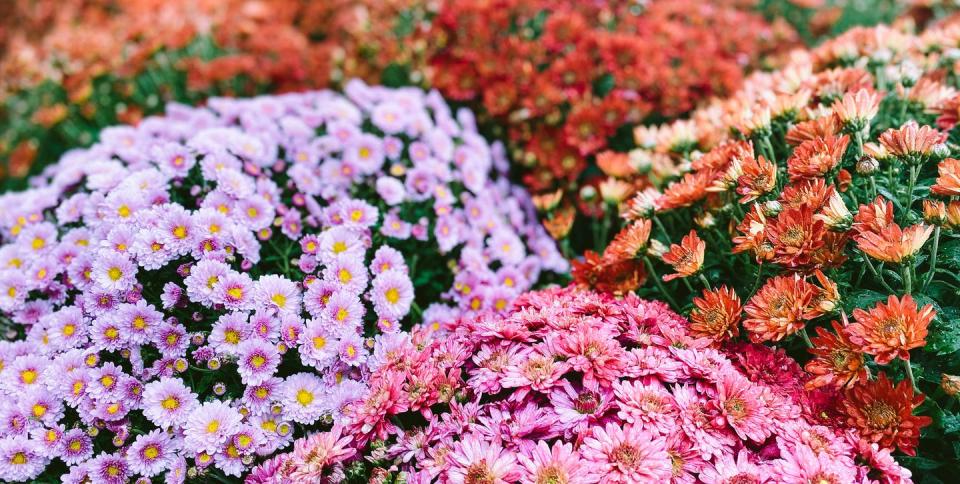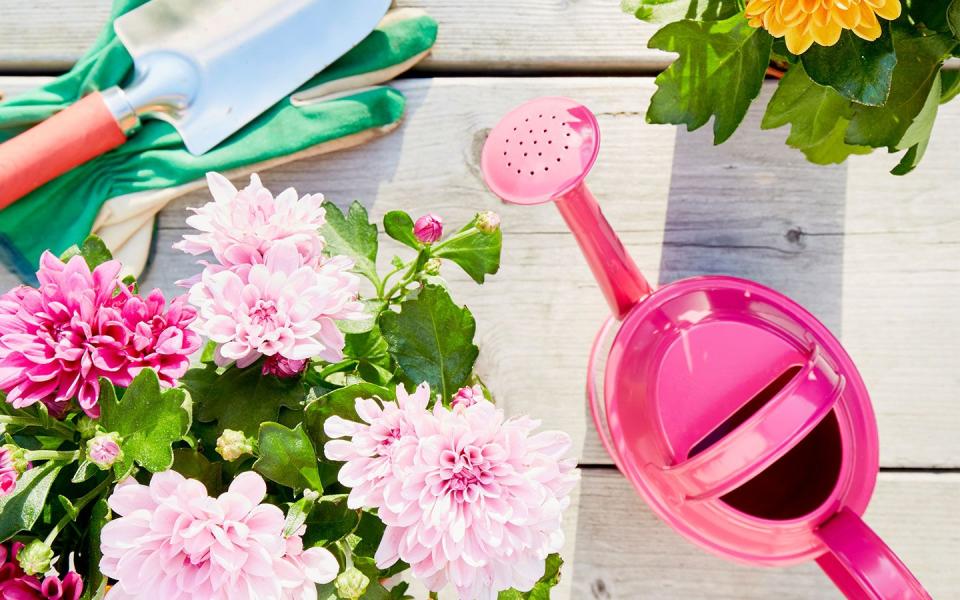How to Grow Show-Stopping Mums in Your Garden

"Hearst Magazines and Yahoo may earn commission or revenue on some items through the links below."
Even if you don't have a huge garden, there's one fall plant you absolutely need: mums! These beautiful flowers are the calling cards of fall, and they're easy to grow. You'll see them everywhere in nurseries, garden centers, and even grocery stores this time of year. Mums, also called chrysanthemums, are pest and disease-resistant, so they're about as low-maintenance as it gets. They work well in pots and in garden beds, too, and come in many different forms with big, lush flowers or daisy-like blooms. They're technically perennials if you get them in the ground early in the season so that they can establish their root systems before winter. But if not, no worries! They're inexpensive enough to treat as annuals, so you can replant new mums next year. Because they come in every color of the rainbow, they're a must-have for your autumn garden or for lining the front steps along with some pumpkins and gourds. Nothing says "welcome" this time of year like these bright, cheery fall flowers!
Growing Tips

Here's what you need to know to grow mums:
Exposure: Full sun
USDA Hardiness Zones: 4 to 9
When to plant: Spring to late summer
Recommended varieties: Hillside Sheffield Pink, Clara Curtis, Mary Stoker
Pests and diseases to watch out for: Aphids, leaf miners, leaf spot
How to Plant Mums
Dig a hole twice as wide as the pot, and place the plant in the hole so that the crown (where the roots meet the stems) are at ground level—and not any deeper! Backfill the soil, water, and mulch to retain moisture and keep down weeds.
How to Care for Fall Mums
Mums are not big feeders, so add a compost when you plant them, then give them a general-purpose slow-release fertilizer in early summer. Water regularly, especially when you're first planting, or they'll wilt on hot days. To encourage a bushier plant with more flowers, pinch off the tips of each "branch" anytime from late spring to early July. Do this a few times a season, but not any later than mid-July or you’ll cut off the flower buds. If you're not into all that effort, it's fine to let them grow into a more free-form shape. Either way, don’t expect pinching to produce that perfectly rounded plant you first brought home from the nursery; those are treated with growth regulators to produce a mounded shape.
If you're keeping them in pots or containers for the season, make sure to water during hot, dry spells in the autumn. Pots dry out much faster than garden beds, so check them regularly so they don't wilt.
Common Questions

Are mums perennial?
Yes, mums are perennials, which means they do come back every year. If you plant mums in spring, the plants have time to settle in and will return in subsequent seasons. But here's the trick: Most people plant mums in fall, which is too late in the year to get them established in time to survive the winter. However, nature is surprising, so sometimes, even if you plant late, they'll return next spring.
How do you divide fall mums?
If your plants are getting floppy or too crowded with your other perennials, use a hand trowel or spade to separate a piece of the plant with the roots, to replant elsewhere. Do this in early spring when you first see new growth.
Should you cut off the dead flowers to help them bloom longer?
No, this isn't necessary and won't create new flowers. Spend your time doing something else fun in the garden!
Can you grow fall mums indoors?

Mums need cold to initiate their flower buds, so you can't bring them indoors like a houseplant. However, you can buy florist mums, which are grown in greenhouses and given as gift plants, much of the year. You can plant these outdoors if you live in a warm climate (typically zones 7 to 9).
Do fall mums need full sun?
Yes! They need full sun, which is six or more hours per day. They can adapt to a little bit of shade, but they won't bloom well. If they start to get too shaded by maturing trees, dig them up and move them in the spring.
How do you winterize fall mums?
Leave mums as-is in place for the winter. Place organic mulch such as wood chips around the base of the plant to protect it from fluctuating temperatures. In the spring, trim off the dead parts. But don't rush to pull out a mum in the spring if it hasn't greened up right away. It may be late spring before you see any activity, so don't get impatient and chuck your plant before you give it a chance.
GROWER TIP: "If you're planting mums in late summer or early fall, choose those in bud to give them the best chance of getting established before winter," says Nancy J. Ondra, author of Grasses: Versatile Partners for Uncommon Garden Design and The Perennial Care Manual. "Mums in full flower are putting energy into flowering, not into growing strong roots."
You Might Also Like

